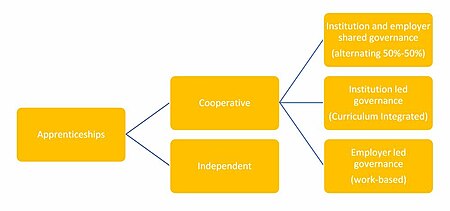Apprenticeship
Most of their training is done while working for an employer who helps the apprentices learn their trade or profession, in exchange for their continued labor for an agreed period after they have achieved measurable competencies.Although the formal boundaries and terminology of the apprentice/journeyman/master system often do not extend outside guilds and trade unions, the concept of on-the-job training leading to competence over a period of years is found in any field of skilled labor.[citation needed] The system of apprenticeship first developed in the Late Middle Ages and came to be supervised by craft guilds and town governments.A master craftsman was entitled to employ young people as an inexpensive form of labour in exchange for providing food, lodging and formal training in the craft.[3] Most apprentices aspired to becoming master craftsmen themselves on completion of their contract (usually a term of seven years), but some would spend time as a journeyman and a significant proportion would never acquire their own workshop.Australia also has a fairly unusual safety net in place for businesses and Australian Apprentices with its Group Training scheme.[citation needed] About 40 percent of all Austrian teenagers enter apprenticeship training upon completion of compulsory education (at age 15).On the one hand, it is a prerequisite for the admission to the Master Craftsman Exam and for qualification tests, and on the other hand it gives access to higher education via the TVE-Exam or the Higher Education Entrance Exam which are prerequisites for taking up studies at colleges, universities, "Fachhochschulen", post-secondary courses and post-secondary colleges.The law states that "the person wanting to educate a young apprentice must prove that he has an ethical way of living and the civic qualities of a good citizen".[citation needed] Organisations such as the Canadian Council of Directors of Apprenticeship and Employment and Social Development Canada help to oversee the programmes.[citation needed] In the Czech Republic, the term "vocational school" (učiliště) can refer to the two, three or four years of secondary practical education.[citation needed] On January 18, 2005, President Jacques Chirac announced the introduction of a law on a programme for social cohesion comprising the three pillars of employment, housing and equal opportunities.In France, the term apprenticeship often denotes manual labor but it also includes other jobs like secretary, manager, engineer, shop assistant...After the civil unrest end of 2005, the government, led by prime minister Dominique de Villepin, announced a new law.Dubbed "law on equality of chances", it created the First Employment Contract as well as manual apprenticeship from as early as 14 years of age.This measure has long been a policy of conservative French political parties, and was met by tough opposition from trade unions and students.[citation needed] Overall responsibility is with the Directorate General of Employment & Training (DGE&T) in the Union Ministry of Skill Development and Entrepreneurship.Instead of formal testing for evaluation, articles of clothing must meet the quality standards before they can be sold and before the apprentice can begin a new design.Its purposes were and still remains to spur economic growth and stability, and sustainable livelihood by financing and investing in human resources through vocational training.[citation needed] In recent years, the Government of Pakistan, through the National Vocational & Technical Training Commission, has begun reforms to modernize the apprenticeship system.Key aspects include:[citation needed] In Switzerland, after the end of compulsory schooling, two thirds of young people follow a vocational training.Many years of hard work and disciplining under the authority of the master is the key to the young apprentice's education and learning process.[citation needed] In Turkey today there are many vocational schools that train children to gain skills to learn a new profession."[29] The number of American apprentices has increased from 375,000 in 2014 to 500,000 in 2016, while the federal government intends to see 750,000 by 2019, particularly by expanding the apprenticeship model to include white-collar occupations such as information technology.[citation needed] In the "Wealth of Nations" Adam Smith states that: Seven years seem anciently to have been, all over Europe, the usual term established for the duration of apprenticeships in the greater part of incorporated trades.






Apprentice (disambiguation)shoemakerElectricianson-the-job trainingjourneymanguildstrade unionsskilled laborinternshipinternships in medicineEuropean CommissionEuropean Center for the Development of Vocational Training (CEDEFOP)Late Middle Agesmaster craftsmanseamstresstailorcordwainerstationerindentureworkshopCoventrystuff merchantsfreemen of the cityWest AfricanDahomeyMyanmarMaturaRed Seal Programprovincecompulsory tradesCanadian Council of Directors of ApprenticeshipEmployment and Social Development Canadajourneymenmaster craftsmenJacques ChiracJean-Louis Borloocivil unrest end of 2005Dominique de VillepinFirst Employment Contracttough opposition from trade unions and studentsmaster chimney sweepApprenticeship in Germanydual education systemMinistry of Skill Development and EntrepreneurshipSOLAS (Ireland)Department of EducationunionsEducation and Training BoardInstitute of TechnologyNational Framework of QualificationsIndustry-led groupssoftware developmentaccounting techniciancommis chefIgbo apprentice systemindenturedeconomic modelSouth-Eastern Nigeriavocational trainingEducation in SwitzerlandelectricianSeljukTurkishWelsh GovernmentApprenticeships in the United KingdomUnited KingdomIndustrial Revolutionact of parliamentApprenticeship in the United StatesSmith–Hughes ActNational Industrial Recovery ActNational Apprenticeship Actwhite-collar occupationsinformation technologyscholarsthesissupervisoruniversitydoctorategraduate studentspost-doctoral fellowsprofessorsmastersprofessional developmentaccountancyengineeringmanagement consultingarticles of clerkshipApprenticeship levyApprentices mobilityApprenticeship in freemasonryEducationEducational theory of apprenticeshipExperiential learningGerman modelGuru-disciple traditionIndentured servitudeMentorshipNonuniversal theorySchool-to-work transitionTraineeTradesmanVocational educationMorgan, Kenneth O.Oxford Dictionary of National BiographyWayback MachineLe tempsAlison FullerOntario College of TradesCertified engineering technicianInterprovincial standardsAgreement on Internal TradeDublin AccordEmploymentAcademic tenureCasualContingent workFull-time jobGig workerJob sharingPart-time jobSelf-employmentSide jobSkilled workerTechnicianTradesperson
